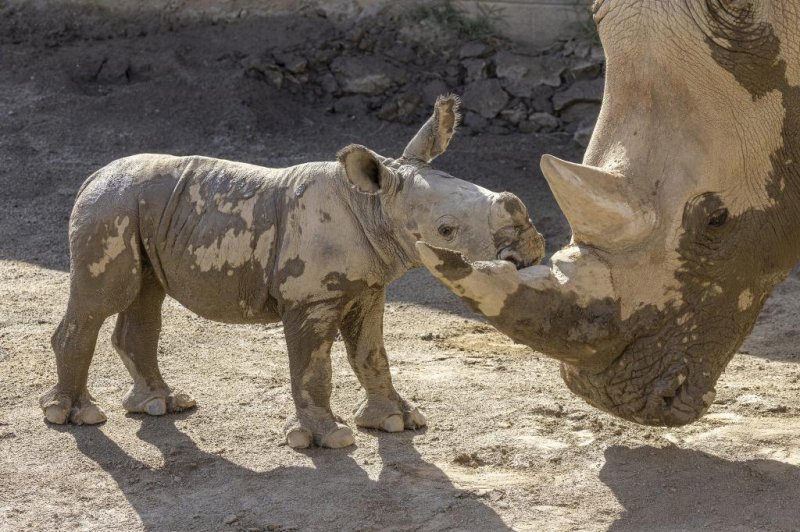By Justin Klawans

A baby southern white rhino was born at the San Diego Zoo in early
Aug. 23 (UPI) -- A California zoo is heralding the birth of a baby southern white rhinoceros in early August.
The San Diego Zoo Safari Park welcomed the male rhino on Aug. 6, born to first-time mom Livia and father J. Gregory, according to a press release from the zoo.
The calf, which does not yet have a name, was conceived naturally, and is reported to be "healthy, confident and full of energy." The zoo added that Livia was "very attentive and protective of her offspring."
The zoo also tweeted a video of the young calf exploring his enclosure with his mom.
"Seeing this energetic little rhino running around, wallowing in the mud and just being generally curious is very rewarding," said Jonnie Capiro, the San Diego Zoo's lead wildlife care specialist. "While this is the first time Livia has given birth, we expected she would be a great mother -- and she proves this every day."
While Livia had not previously given birth, she had cared for an orphaned rhino named Arthur in 2020, and the zoo reported that she had shown strong maternal instincts with the baby.
"All rhino births are significant, and this calf's birth represents an essential step in San Diego Zoo Wildlife Alliance's Northern White Rhino Initiative, showing Livia can carry a calf to term and care for her offspring," added Barbara Durrant, the San Diego Zoo's director of reproductive sciences. "This is vitally important, as Livia is now among the female rhinos at the Nikita Kahn Rhino Rescue Center who could potentially serve in the future as a surrogate mother to a northern white embryo."
The Nikita Kahn Rhino Rescue Center is a portion of the zoo dedicated to rhino conservation, working with southern white rhinos in an effort to save its sister subspecies, the northern white rhino.
Southern white rhinos have seen dwindling populations due to poaching, but, despite being listed as endangered, there are still an estimated 18,000 in the wild.
The northern white rhino, however, is one of the most critically endangered animals on Earth.
The subspecies is believed to be extinct in the wild, and the last two remaining northern white rhinos on the planet live at a conservancy in Kenya.
Both of these rhinos, though, are female, and are unable to reproduce naturally. The last male northern white rhino, Sudan, died in 2018.
Facilities like the Nikita Kahn Center are using the southern white rhino in an attempt to repopulate the northern white subspecies artificially.
This includes technologies such as "artificial insemination, in vitro fertilization and embryo transfer."
"An interdisciplinary team -- including wildlife care and health teams, reproductive physiologists and geneticists -- are working with southern white rhinos as a model for developing these advanced reproductive technologies," the zoo said. "The ultimate goal [is] to establish a sustainable population of northern white rhinos using banked genetic material.
At least two of the southern white rhinos at the San Diego Zoo were born via artificial insemination.
While both subspecies remain officially endangered, there have been some strides made in recent years.
In 2019, researchers in Europe were able to successfully fertilize a pair of northern white rhino eggs, marking a breakthrough in the fight to save the animal.




:focal(221x169:222x170)/https://tf-cmsv2-smithsonianmag-media.s3.amazonaws.com/filer_public/ac/8b/ac8bb1fb-3fb1-4474-a708-4abbd45634bf/capture.jpg)

.jpg)





.jpg)
